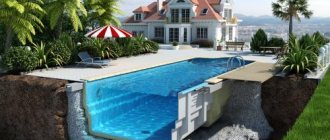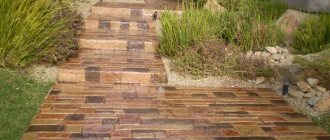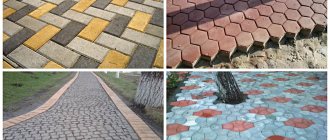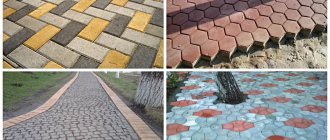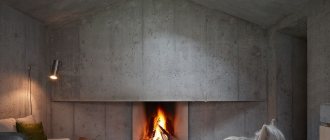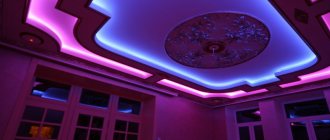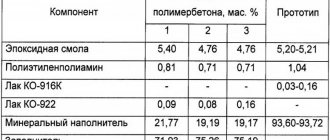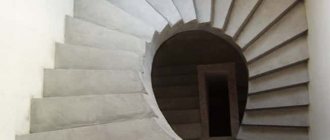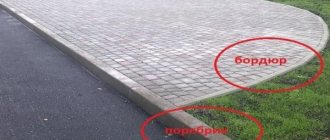Hello dear readers. In today's article we will tell you how to properly make pigment for concrete with your own hands. We sincerely hope that the information received will bring you maximum benefit, and that you will return to our site more than once in search of answers to your questions.
Most people are used to gray concrete. However, thanks to the latest developments in construction, this material has received a very different color palette of shades. And it happens like this: a special powder is added to the cement mortar, which makes it possible to create any color scheme. Often this coloring is used for sidewalks, paving stones and curbs, and sometimes multi-colored concrete is used to decorate small particles on the facades of premises.
To properly color concrete, it is necessary to add powder dyes when mixing it. Pigments are special additives that give the finished product a certain color shade. Such dyes come in the form of microcapsules, emulsions or concentrate pastes.
The following properties of the pigment composition can be distinguished:
- coloring power and hiding power,
- dispersion and oil absorption,
- alkali resistance and light resistance.
Using this material in practice, you can decorate any yard. There are a large number of painting methods, but if you understand them, having studied all the pros and cons, then it will not be so difficult to do. In addition, made by hand, it has a high coloring ability and is resistant to environmental influences, intense light and high temperature.
Various color solutions are becoming increasingly popular in construction. This is especially true for concrete pigments, which are added to a special solution during mixing or applied to an already prepared surface.
At the same time, the components that convey color can be synthetic and natural, and the saturation depends on the amount of chemicals in the solution. For example, to get a red tint, you need to oxidize iron. If we talk about white color, then double oxidation of titanium will be required.
More natural additives for coloring include components such as:
- chrome and red lead,
- manganese and iron.
It is in this way that you can easily obtain many dyes for concrete.
Making Tips
An unattractive and dull color can be replaced with any other shade. There are several ways to do this. As a rule, the necessary substances are added while mixing the solution.
To paint a finished reinforced concrete product, you can use a special paint, and if you want to save money, it is better to use dyes while the structure is being poured.
This type of pigment easily dissolves in water. For concrete mortar it is better to use alkyd or acrylic paint. Experienced construction specialists know how to use not only dry pigments, but also a wide variety of emulsions, paste concentrates and microcapsules with fillers.
How cement is selected for making colored concrete
When producing colored concrete, any type of cement can be used. However, it should be remembered that the primary color of the cement composition directly affects the final shade of the concrete. Gray, for example, mutes tones and reduces saturation. For this reason, when bright or rich shades are required for concrete, it is best to use white cement.
The level of saturation also depends on the pigment, because when it is added, only the cement stone is colored, which covers the pigment particles with a thin layer. Under the influence of external factors, the filler is exposed and slightly changes its shade. In any case, the color of concrete depends not only on the pigment dye, but also on the choice of cement.
What dyeing methods are there?
There are two options for staining concrete, and, of course, each of them has some nuances that you should pay attention to. If we talk about painting a finished object, then it is somewhat reminiscent of painting walls, which gives a shade to the finished structure.
A more preferable option is when colored powder is added to the solution - even if the top layer is abraded, the color will not be lost. The main and only disadvantage of this technology is considered to be the high cost of processing, since in order to give a deep and rich color, a large amount of coloring pigment is required - and it is not cheap.
If we are talking about the production of paving stones, tiles for sidewalks and borders, then it is customary to use this particular method of painting. It is also advisable to use it for monolithic pouring of colored concrete paths, platforms and retaining walls. However, such a surface often does not require painting.
The next technology for processing already finished products and structures is that a layer of paint is applied to the finished product, which paints the concrete element well. You can also use various types of penetrating varnishes and clear bases for façade paints.
Important! Along with the top layer, the paint also wears off, so preference is given to the first painting method.
Painting methods
Coloring concrete mortar can be done using two methods:
- At the stage of preparing the mixture;
- After the concrete has hardened.
The first method is considered more appropriate, since concrete painted during manufacture has a longer service life. In addition, the paint layer does not have to be refreshed periodically.
The process of painting concrete using the second method is similar to the procedure for painting the walls of a building. However, it is worth remembering that in your work it is necessary to use pigments that can penetrate deep into the monolith (at least 2 mm). If you ignore this requirement, the quality characteristics of the dye will significantly decrease.
A few words about dyes
In the modern world, the building materials market offers a wide range of pigments for painting cement products. Therefore, when choosing a dye, you need to remember: the service life of the concrete itself without additional tint will depend on its quality.
Coloring compositions come in the following types:
- acrylic and dry,
- simple and colorful
- acidic or iron oxide.
It is quite natural that each additive has its own characteristics in preparation and application, as well as its own nuances during use.
Acid dyes are considered the most popular, have a transparent powder texture, and are absolutely safe. There are several standard shades such as white, red and yellow, as well as blue, green and yellow, but by mixing, beautiful new colors can be created.
To prepare the mixture for painting, you will need a solvent, additives and an adhesive. First, the powder elements are mixed, and only then the liquid ones are added.
First of all, the concrete surface must be cleaned and coated with a solvent. Then the painting itself is done, and in order to protect yourself from acid, you need to use a protective suit, as well as protect all unstable objects that are nearby.
After a certain amount of time, when everything has dried, it is necessary to wash off the residue and dry the resulting structure. The whole process will take a day.
At the same time, when mixing elements, it is necessary to strictly observe the proportions. And if you make an iron oxide mixture, then it is best to give preference to white cement.
Iron oxide dyes are often used at the production stage, and ease of use makes it possible to independently make this masterpiece with your own hands. It is advisable to pre-mix concrete pigments with cement to obtain richer and deeper colors.
Acrylic pigment is used in cases where a durable coating is needed, so it is often used for finishing wall structures and floor coverings.
The dye can be easily applied with your own hands using a roller, and all work can be done indoors or outdoors. To speed up the process itself, you can use a sprayer, and if a bright shade is required, you should apply the pigment in several layers.
This coating will last a long time, and the paint will not emit harmful substances and will dry quickly.
If we talk about simple dyes, they are easy to apply to the surface, and they have a wide palette of shades, however, they are not recommended for use outdoors, as they can fade, so they are recommended to be used only indoors.
Such pigments are in the form of a powder, which is diluted with water or a special solvent. For painting it is better to use a sponge or roller. After application, the paint will dry quickly.
Dry pigments are considered one of the best materials. They also have a large palette of different shades. In addition, such dyes are only suitable for new concrete, which does not require any treatment.
This dye is not mixed into concrete, but is only suitable for surface treatment. It is applied using a trowel or spatula and leaves a dense, uniform layer.
There are also colored additives that are mixed inside the raw concrete; they can be liquid or dry, and come mainly in light colors that last a long time and hardly fade.
Which pigment dye is best to choose for painting concrete with your own hands?
Cement dyes or pigments are powdered additives that impart different colors to cement or mortar.
Once dry, these components do not dissolve and are not exposed to water, oils or other liquids. Also, if they are of good quality, they are not exposed to sunlight or rain.
Dyes for cement must have the following properties:
- High level of coloring ability. It is imperative that the pigment can transfer its color to the cement;
- It must cover the color of the item to which it is applied;
- Dispersity. Thanks to this property, the color coverage properties and dyeability are increased;
- High level of oil absorption. This property consists of the ability of paint particles to retain oil on the surface of the product;
- High light fastness. This property is to retain color even under strong exposure to sunlight.
But what pigment dye to choose for coloring concrete products is quite a difficult task. Therefore, you first need to consider the types of pigments that are used for cement products.
Acid dyes for concrete
Acid dyes are the most popular method for painting concrete products.
This dye has a powdery composition that has a transparent structure. It does not have a harmful effect on the environment and does not harm human health. When painting, it reacts with the cement and turns it into the desired color.
Acrylic dyes for concrete
Acrylic-type pigments are used for painting cement products in areas where long-lasting paint retention is required.
Therefore, it is an ideal option for painting floors and walls. The required color is selected directly on site in the store. The choice of colors is quite wide. In addition, there are no problems during mixing. This paint can be applied to surfaces both inside and outside the house. The dye has no harmful effects and dries quickly.
Dry dyes for concrete
Dry dyes are great for those who want to add a pop of color to their yard. The range of these dyes offers a huge selection of colors. By the color of the powder you can immediately guess what color the concrete products will be painted.
Features of dry dyes:
- The color tolerates any weather conditions well. Does not collapse under the influence of rain and sunlight;
- Dry paints are best used for new concrete that has not previously been subjected to any treatment;
- Only the surface of the product should be painted with the dry mixture;
- The composition contains substances that ensure long-term retention of the mixture on the surface and strengthen the structure of the cement.
Remember that the powder does not dissolve in water. To dissolve, use a special professional solvent.
Colored additives for concrete
These components are used to produce colored material. Additives can be either in liquid or powder form. They are added to the raw cement solution. The shades of these additives mainly come in light and bed tones.
Cement structures to which color additives have been added are painted throughout the entire structure. For this reason, the paint does not deteriorate under the influence of rain and sunlight. It is not afraid of damage, deformation, or potholes. The color will last as long as the product itself lasts.
Final part
Since the color range of dye pigments is not very large, in order to obtain the desired shade, you can mix several different colors. In this case, the base must be treated with a solvent.
Making your own dye and painting concrete is not at all difficult, you just need to follow all precautions.
That's all, our next article has come to an end. We believe that the information provided will be useful to you and you will be able to make your construction dream come true. And, in turn, we will help you with this as much as possible. Visit our website and learn new and interesting stories that relate to the nuances of construction.
DIY composition
You can make a simple dye at home. It’s not difficult to even get a large number of shades if you know how to make pigment for concrete with your own hands. In terms of price, it will not be expensive, but will have some disadvantages.
If you use a low-quality dye, then after painting the product will be negatively affected by sunlight and temperature changes. Simple dyes are usually used for decoration. The dry composition is mixed with water or a solvent. Before preparing, you must also take into account the color of the concrete.
READ Types of glue for linoleum on concrete floors and gluing technology
To lighten the white color, you need to add only 1-2% titanium dioxide. To prepare paving slabs, it is better to add mineral-based pigments in a proportion of 1-5%.
It is advisable to first study the range of shades that can be obtained after adding a pigment shade. For example, white color is obtained by adding chalk or limestone. Black pigment for concrete can be made using soot, but during use it is quickly washed off. It is better to use black iron oxide, which is considered more durable.
You cannot load all the components at once and simultaneously, since good dispersion cannot be achieved this way.
